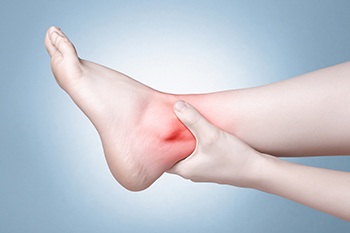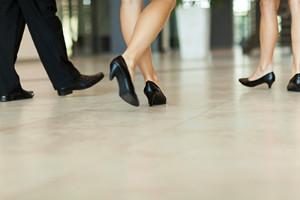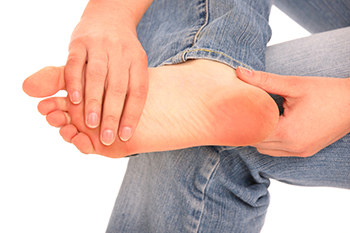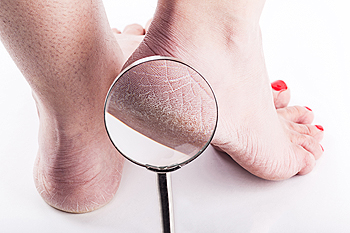The ankle is the region that joins the foot and leg. It consists of three joints that allow the foot to move. Pain in the ankle is typically the result of injury or inflammation from a wide variety of conditions, such as strains, sprains, fractures, or arthritis. Symptoms that often co-occur with ankle pain include swelling, bruising, numbness, tingling, stiffness, joint instability, and difficulty walking.
The underlying cause of your ankle pain can be diagnosed by a chiropodist. A diagnostic visit to this specialist typically involves providing a medical history, describing your ankle pain, and undergoing a physical examination. In some cases, the chiropodist may order imaging studies, such as an X-ray or ultrasound, to rule out or confirm a diagnosis.
The right treatment for your ankle pain will depend on the underlying cause of the pain. In many cases, your chiropodist may recommend that you follow the R.I.C.E. acronym: resting, icing, compressing, and elevating the affected ankle. Taking these actions generally decreases swelling and inflammation, reduces pain, and promotes healing. Taking over-the-counter, nonsteroidal anti-inflammatory drugs may also help with pain management. The chiropodist may also prescribe custom orthotics, immobilize the affected ankle, or recommend activity and footwear modifications. In cases of more severe injuries, surgical treatment may be necessary.
If you are experiencing ankle pain, it is recommended that you seek the care of a chiropodist.

The ankle joint is a complex combination of bones, muscles, ligaments, tendons, and nerves. For that reason, there are many causes of ankle pain. The most common is a sprain, which happens when a ligament is stretched beyond its normal range and tears or ruptures. Another cause of ankle pain is stress fractures, which are hairline cracks in the bones that are caused by the type of repetitive pounding that occurs while running or playing sports. Other causes of ankle pain include arthritis, gout, and Achilles tendonitis. Gout is an inflammatory condition related to the overabundance of uric acid in the body. Crystals can form within the ankle joint and cause extreme pain. Achilles tendonitis is largely the result of overuse in the tendon that attaches the calf muscles to the heel. Resting the ankle is the first on the treatment list, but if bearing weight on the injured foot is difficult or impossible, it is suggested that you consult a chiropodist for help.
Ankle pain is a common symptom of many lower limb problems. If you are experiencing ankle pain, please consult with one of the chiropodists from The Footcare Centre. Our chiropodists will assess your condition and provide you with quality foot and ankle treatment.
The ankle is composed of a number of muscles, bones, tendons, and ligaments. There are many conditions which may cause ankle pain.
Causes
Ankle strains or sprains
Achilles tendon injuries
Fractures
Bursitis
Arthritis
Gout
Tarsal tunnel syndrome
Symptoms
If you have ankle pain, you may also experience a variety of other symptoms depending on the underlying cause of the pain. Some of these symptoms may include ankle swelling, bruising, redness, numbness or tingling, instability, and difficulty walking.
Diagnosis
The underlying cause of ankle pain can be diagnosed by a chiropodist. Diagnoses are typically made based on your medical history, a physical examination of the affected ankle, and imaging studies such as X-rays.
Treatment
Treatment for your ankle pain will depend on its underlying cause. Often, the chiropodist will recommend that you rest the affected ankle. You might also need to ice, compress, and elevate the ankle, wear an orthotic device, or take medications to reduce pain and inflammation.
If you have any questions, please feel free to contact our office located in . We offer the newest diagnostic and treatment technologies for all your foot care needs.
Standing for prolonged periods of time can cause damage to your feet. Unfortunately, this is a necessary part of the job for many working people. Common foot conditions that may occur as a result of being on your feet all day include foot pain, blisters, calluses, corns, arthritis, toe deformities, sprains, bunions, athlete’s foot, and fallen arches.
There are certain steps that you can take to prevent work-related foot problems. If you are on your feet all day, it is recommended that you avoid shoes that have high heels, pointed toes, a fit that is too loose or too tight, and a lack of arch support. If you work in a place where foot injuries are a common occupational hazard, such as a construction zone, wearing the right shoes becomes increasingly important. Wearing comfortable, properly fitted, supportive shoes made of breathable materials can mitigate the risk of developing a variety of foot problems.
Maintaining an immobile, upright stance for prolonged periods of time is bad for your foot health. If possible, take breaks throughout the day to sit down, stretch, and walk around. At home, take care of your feet with a daily foot care routine. Wash the feet daily with soap and water and dry them thoroughly. Apply a moisturizer to prevent cracked heels. When trimming the toenails, trim straight across to avoid ingrown toenails. Wear clean socks daily. If you notice any problems developing in your feet or ankles, consult with a chiropodist, who can diagnose and treat your condition and help you maintain the health of your feet.

Blisters, shin splints, and swollen feet are just a few of the foot problems that can result from standing all day at work. There are various ways to take the load off your feet, during your working hours and after. Some of these include making sure to wear properly fitting, supportive, cushioned, close-toed, and comfortable shoes. Using anti-fatigue mats for repetitive tasks, doing exercises to strengthen the feet and legs for demanding work endurance, and taking regular breaks also help. Massaging your feet and soaking them after work may help relieve aches and pain. There are many other ways to prepare and take care of the feet when you must stand on them for prolonged periods. It is suggested that you visit a chiropodist to find out more.
If you stand all day, you may be at an increased risk of developing various foot conditions. If you are experiencing foot pain of any kind, please consult with one of the chiropodists from The Footcare Centre. Our chiropodists will assess your condition and provide you with quality foot and ankle treatment.
What Foot Problems Are Caused by Standing?
Standing all day at work may increase your risk of developing foot or ankle problems.
Some common foot conditions that may arise from spending all day on your feet include:
Foot pain
Blisters
Corns and calluses
Arthritis
Flat feet
Bunions
Sprains
Athlete’s foot
Prevention
If you stand for prolonged periods of time for work, taking preventative measures to preserve the health of your feet is strongly recommended.
Measures you can implement to help prevent foot problems include:
Wearing shoes that are comfortable and fit well - these shoes should be made of breathable materials and provide you with arch support and cushioning. It is best to avoid shoes that have heels or narrow toe boxes.
Taking breaks to rest, walk, and stretch your feet throughout the day
Maintaining good foot hygiene - wash and dry your feet thoroughly every day
If you have any questions, please feel free to contact our office located in . We offer the newest diagnostic and treatment technologies for all your foot care needs.
Participating in sports is great for maintaining your health and fitness, but can sometimes result in injuries to your feet or ankles. Common sports-related foot and ankle injuries include Achilles tendonitis, ankle sprains, stress fractures, turf toe, and plantar fasciitis.
Achilles tendonitis is a common injury in which the Achilles tendon located at the back of your ankle becomes inflamed due to overuse or biomechanical issues with the feet. Symptoms of Achilles tendonitis include pain in the lower calf, swelling, stiffness, redness, warmth, and reduced strength and range of motion.
Ankle sprains occur when the ligaments in the ankle are overstretched or torn. Depending on the severity of the injury, you may experience symptoms such as localized pain, swelling, and bruising at the site of the sprain, a limited ability to move the affected ankle, and difficulty walking.
Stress fractures are fine cracks that occur in the bones when they can’t bear the load placed on them. These fractures often occur in the foot bones and get worse over time if they are not promptly diagnosed and treated. Symptoms of stress fractures in the feet include tenderness, deep and dull or sharp and localized pain, weakness, swelling, and bruising.
Turf toe is a sprain of the largest joint in the big toe. It can cause symptoms such as pain, swelling, or tenderness that vary in intensity depending on the severity of the injury.
Plantar fasciitis is an inflammation of the ligament that runs along the bottom of the foot. This condition usually causes stabbing heel pains, arch pain, and pain when taking your first steps after a long period of rest.
If you have injured your feet or ankles while playing sports, it is recommended that you see a chiropodist who can diagnose and treat your condition and get you back on your feet.

Some people find the elliptical machine to be an enjoyable and effective form of cardio fitness. These machines typically include an arm workout along with the movement of the legs. It is important to use these machines properly as repetitive stepping motion can cause foot pain. Heel pain is often a risk of using such machines in the wrong way. Some things to tend to when relying on this form of exercise include wearing running shoes that are comfortable and supportive, stretching the feet before embarking on a workout, and making sure feet are placed flat on the pedals of the machine rather than pushing off from the toes. If you use the elliptical machine as a form of exercise and would like to learn more about using it safely, it is suggested that you consult with a chiropodist for more advice.
Injuries to the foot and ankle are very common among athletes. If you have experienced an injury, please consult with one of the chiropodists from The Footcare Centre. Our chiropodists will assess your condition and provide you with quality foot and ankle treatment.
Common Injuries Among Athletes:
Achilles tendon injuries
Ankle strains or sprains
Plantar fasciitis
Fractures
Turf toe
Joint dislocations
Sever’s disease
Morton’s neuroma
Symptoms
Symptoms will depend on the cause and severity of the injury. Common symptoms for a foot or ankle injury include pain, swelling, tenderness, bruising, a reduced range of motion, and difficulty bearing weight or walking on the affected foot or ankle.
Diagnosis
Sports injuries are typically diagnosed after carefully examining the affected foot or ankle. This includes moving the injured area to test its range of motion. Medical history will need to be provided, as well as detailed information about how the injury occurred. Imaging studies, such as X-rays or MRIs, may be used to confirm or rule out certain diagnoses.
Treatment
Just like symptoms, treatment will depend on the type of injury and its severity. Initial treatment for many sports injuries is aimed at controlling inflammation and promoting the healing response. The acronym R.I.C.E is a helpful guide to implement for most acute injuries. This method involves resting, icing, compressing, and elevating the affected foot or ankle. In addition, anti-inflammatory medications may be administered and orthotic devices may be prescribed. For more severe injuries, surgery may be required. Lastly, rehabilitation or physical therapy may be needed to gain full functionality in the afflicted area.
If you have any questions, please feel free to contact our office located in . We offer the newest diagnostic and treatment technologies for all your foot care needs.
When the skin on the heels is dry, it may begin to crack. These cracks are not just unsightly, they can also be uncomfortable or deep and painful. In some cases, these heel cracks can even bleed, increasing their risk of becoming infected. This can make walking, standing, or even bearing weight on the heels difficult.
Cracked heels can be caused by a variety of factors. These include prolonged standing, wearing open-back shoes or shoes that don’t cushion the heels, living in a cold or dry climate, taking long, hot showers, and not moisturizing the heels, as well as various medical conditions, such as eczema, psoriasis, palmoplantar keratoderma, or juvenile plantar dermatosis.
The best way to prevent and treat mild cases of cracked heels is to regularly soak the feet, exfoliate the heels with a pumice stone, and then moisturize them. It is also best to avoid wearing open-back or thin-soled and unsupportive shoes. In more severe cases, it is suggested that you seek the care of a chiropodist, who can help you manage your cracked heels and overall foot health. People who have cracked heels and diabetes or a weakened immune system should also be under the care of a chiropodist.

Mildly cracked heels may feel better when a good moisturizer is applied daily. This is a foot condition that can happen for various reasons, including standing on hard surfaces for most of the day. It may also occur from wearing shoes that have an open back, such as flip flops, or possibly from washing the feet with harsh soaps. There may be existing medical conditions that can cause cracked heels to develop. This condition may be common for diabetic patients to get, who are often aware of the serious consequences if prompt medical attention is not received. Many people who are diabetic are unable to feel cuts on their feet, and cracked skin on the heels may rapidly become infected. Some people get cracked heels from a vitamin deficiency, or from a skin or thyroid disorder. If you have cracked heels, it is strongly suggested that you are under the care of a chiropodist who can provide you with the correct treatment techniques.
Dry, cracked heels are more than a cosmetic inconvenience. For many people, they are uncomfortable, deep, painful, and may even bleed. If you suffer from cracked heels, please consult with one of the chiropodists from The Footcare Centre. Our chiropodists can help you maintain the health of your lower limbs and your mobility.
Causes
Prolonged standing
Wearing open-back shoes
Wearing shoes that don’t cushion the heels
Living in a cold or dry climate
Taking long, hot showers
Not moisturizing the heels
Eczema
Psoriasis
Palmoplantar keratoderma
Juvenile plantar dermatosis
Treatments
Soaking the feet
Exfoliating with a pumice stone
Moisturizing the heels
Wearing closed-back shoes that cushion heels
Avoiding prolonged standing
Taking warm, rather than hot, showers
Treating underlying skin conditions
While milder cases of cracked heels can be treated at home, some patients present with deep, painful, bleeding heel fissures that are at risk of becoming infected and may require medical care. Additionally, patients with diabetes or any other conditions that affect the immune system should be monitored by a chiropodist.
If you have any questions, please feel free to contact our office located in . We offer the newest diagnostic and treatment technologies for all your foot care needs.


